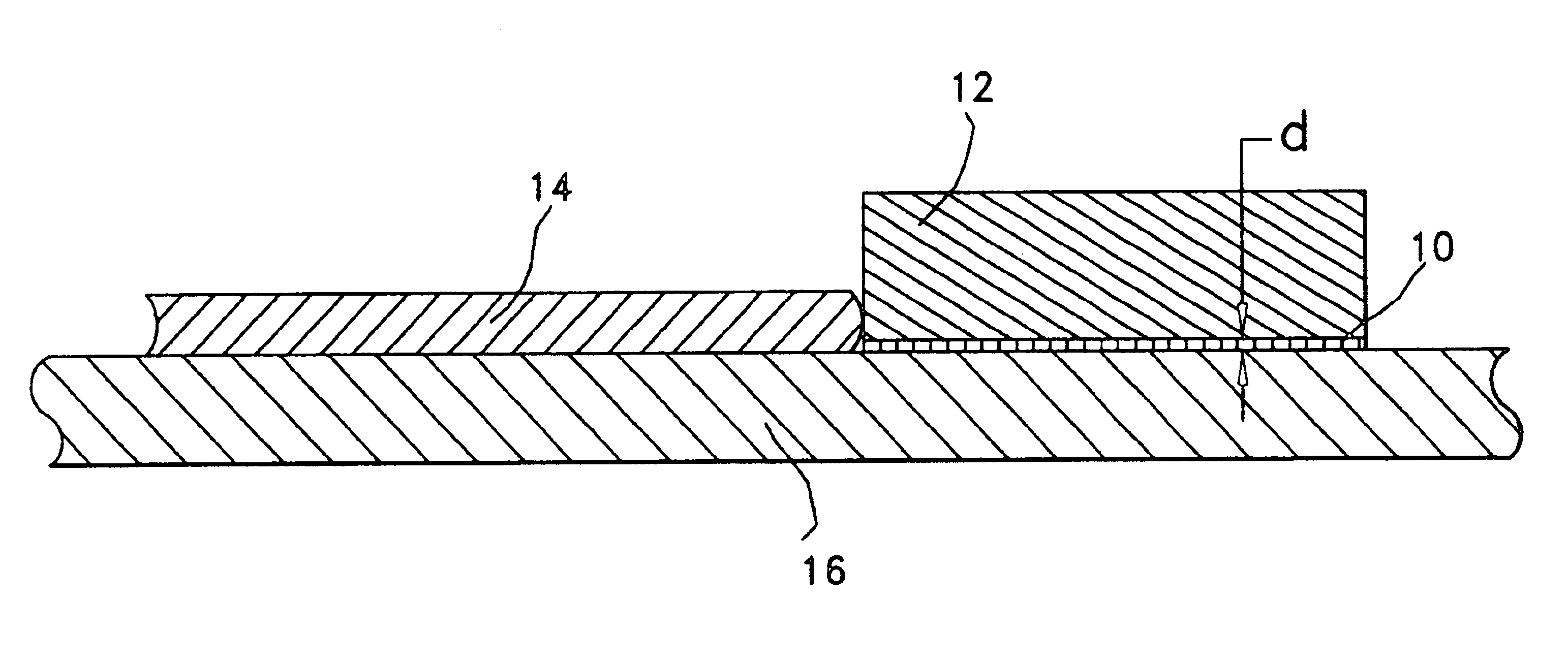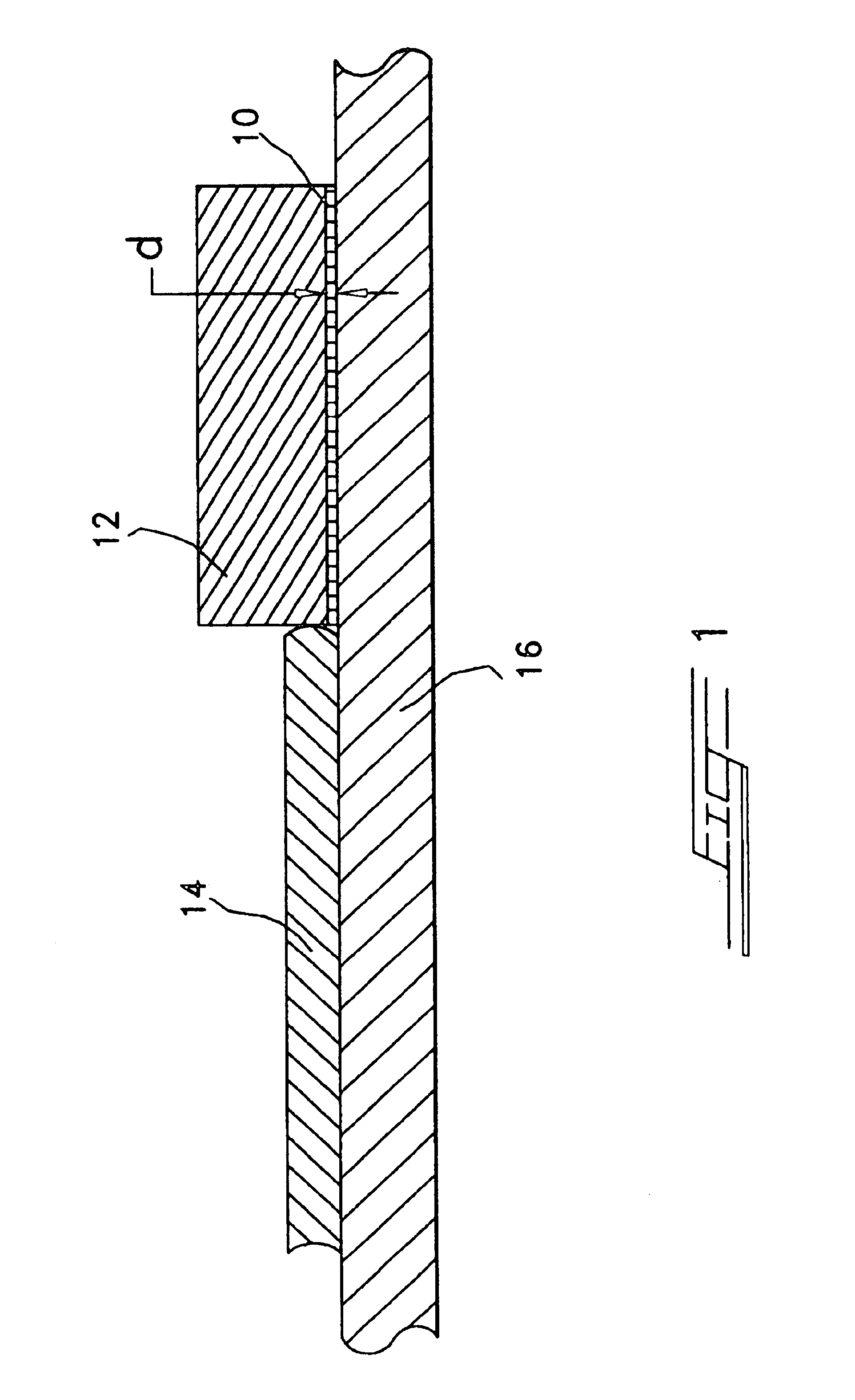Retaining ring with wear pad for use in chemical mechanical planarization
a technology of mechanical planarization and wear pad, which is applied in the direction of grinding drive, manufacturing tools, lapping machines, etc., can solve the problems of high cost of cmp equipment operation, abrasion slurry, and subject to polishing action, so as to increase the operating temperature and pressure, reduce the effect of wear
- Summary
- Abstract
- Description
- Claims
- Application Information
AI Technical Summary
Benefits of technology
Problems solved by technology
Method used
Image
Examples
first embodiment
[0020]Referring to the drawings in greater detail, there is shown in FIG. 1 a cross section of the annular retaining ring with wear pad for use in CMP processes, wherein a thin, 0.010 of an inch or less, annular wear pad 10 is adhesively attached to the bottom of annular retaining ring 12, which retaining ring is constructed of a thermoplastic material, such as PPS. A semiconductor wafer 14 to be polished by a polishing head of a CMP apparatus is shown abutting the inside annular surface of the retaining ring 12 and retained thereby. The bottom surface of the wafer 14 and the annular wear pad 10 are in contact with polishing pad 16 of a conventional polishing head assembly described hereinbelow with reference to FIG. 2. The embodiment of FIG. 1 significantly reduces retaining-ring wear by replacing about 0.010 inches or less at the contact surface of the retaining ring with about 0.010 inches or less of the thick wear pad 10 of material bonded to the PPS of the retaining ring. While...
second embodiment
[0028]FIG. 3 is a cross section of a second embodiment, wherein a relatively thick annular wear pad 20 is inserted into a bottom, outer annular, cutout portion 22 of retaining ring 22, such that the wear pad 20 is in contact with the polishing pad 16. The portion of the retaining ring that contacts the wafer 14 at its interior annular surface has a relieved section 24 at its the bottom thereof, so that retaining ring proper does not contact the polishing pad 16. The relieved section 24 extends outwardly from the interior annular surface toward the exterior, or outer, annular surface of the retaining ring, such that it extends until reaching the interior annular surface of the wear pad 20. Preferably, but not required, the relieved section 24 has a depth “d”, as measured from the top toward the bottom of the retaining ring, that is less than the depth, or height, of the wear pad 20, as seen in FIG. 3. The wear pad 20 protrudes about 0.010 inches or less beyond this relieved section 2...
third embodiment
[0029]FIG. 4 is a cross section of a third embodiment, wherein the annular retaining ring 32 is comprised of wear-pad material, thus effectively making the retaining ring 32 one large wear pad itself. The retaining ring 32 is formed with a bottom, interior annular cutout section or portion 34, in which is adhered, or otherwise formed, a relatively small, interior, annular or ring-shaped force-absorbing insert 36, of a suitable thermoplastic material, such as PPS, in order to act as a bumper against the wafer 14 during polishing. There is a gap “d” between the bottom surface of the annular, force-absorbing insert 36 and the bottom surface of the retaining ring, so that the force-absorbing ring 36 does not contact the polishing pad 16. The bottom surface of the annular retaining ring / wear pad combination protrudes preferably about 0.010 inches or less below the insert 36, so as to effectively provide a wear-pad section that resists the heat and abrasion of the polishing operation.
PUM
 Login to View More
Login to View More Abstract
Description
Claims
Application Information
 Login to View More
Login to View More - R&D
- Intellectual Property
- Life Sciences
- Materials
- Tech Scout
- Unparalleled Data Quality
- Higher Quality Content
- 60% Fewer Hallucinations
Browse by: Latest US Patents, China's latest patents, Technical Efficacy Thesaurus, Application Domain, Technology Topic, Popular Technical Reports.
© 2025 PatSnap. All rights reserved.Legal|Privacy policy|Modern Slavery Act Transparency Statement|Sitemap|About US| Contact US: help@patsnap.com



